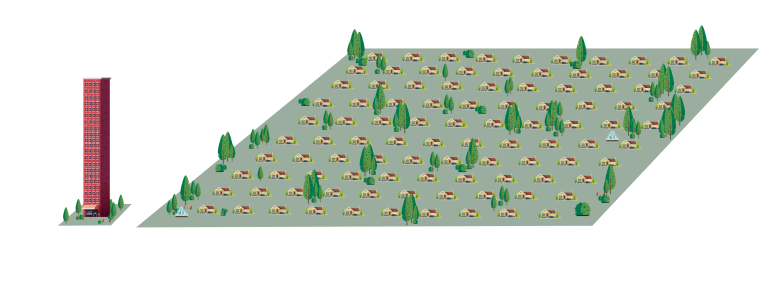Thickening is currently a very politicized topic. After all, let’s face it, if we have an enemy in common with us, we are more willing to lean to a specific side. This strategy of getting closer to people is always based on values that are close to the people, such as peace, privacy or enough space. And so when another building is built, we still lose some comfort. This is how it is presented. If there is something we don’t think too much about, we tend to be content with an explanation that sympathizes with us and supports our beliefs. Such objectively unsubstantiated assumptions are the result of negative prejudices. The technical term for combining two variables without an objectively existing association between them is called illusory correlation and is one of the cognitive prejudices favoring the powerful.
Let’s take a specific example from the development environment.
After the announcement of the intention, people present their opinion that the announced construction must naturally worsen traffic in the given area. But the real cause of the deteriorating traffic situation is not a specific project but also, for example, the growth of the Slovak economy. Among other things, it has caused a 60% increase in car ownership over the last ten years. For a better idea of the original 243 cars per 1000 inhabitants (2005), the same number of inhabitants now includes 390 cars (2015). So even if nothing had been built in Bratislava in the last ten years, the increase in the number of cars would have been the same, and therefore denser traffic and more complicated parking. Do you see where we are going?

We see the reason for the negative perception of new development plans in two factors. One is the previous negative experiences with the dishonest approach of several developers and the public’s lack of interest in perceiving the deeper connections that create and influence development.
Residential development is about working with people, about communication and, ultimately, taking into account the voice of the majority
However, it often happens more and more often the developer enters the territory without a proper hearing of the opinion of the public concerned. And it is precisely this step that turns the whole project from a benefit to an ugly conflict. However, we look at the development of space differently. A good start is to put on the shoes of the future neighbor of our project and try to doubt as much as possible about the content of our work, its results and impacts on society or the environment. As developers, we build different types of buildings for different purposes and we believe that every single building has its significance for the surroundings and location.
Dozens of projects are currently growing in Bratislava as well. When watching them, the wave of reluctance on the part of neighbors or other residents is really noticeable. The most common and partially substantiated arguments as to why projects are bad and should not be built include:
- The planned construction should be at the expense of the green area or trees
- The parking situation will worsen
- Why are there other flats that will live in them?
Why partially justified? In some cases, there is really an unreasonable stop and unnecessary felling, or the original greenery is not sufficiently replaced. But that is a topic in itself.
Let’s start with a simple fact – we all need and want to live somewhere
We rank housing among basic human needs. Children become independent, leave their parents’ homes and look for their own place, their own home. Multi-generational housing is now becoming more of a rarity. If we take the statistics from the last few years, the population of Slovakia has grown by about 0.1% year on year, which is about our population approx. 5,400 new inhabitants per year. If we were to assume that out of 5,400 people, half of the women and half of the men will be mating with each other and finding new housing together, we would need 2,700 new flats a year (a very rough estimate, of course, everyone has a different living environment). The situation, different work, different marital status, etc.). This is the answer to why new housing should be built.
An alternative to apartment buildings is family ones, for which in most cases developers are not needed. A group of friends would probably not decide to build apartment buildings, with the proviso that they would then live there together with their families. In this, we would see the difference between a developer and a person who builds housing himself.
The developer does not just build apartments but the building as a whole. And this is a difference that is often forgotten
Imagine 100 families needing to live. For example, they can be three members, which is a total of 300 people looking for their future home. The developer would build an apartment building for them, for example, 20 stories, with three-room apartments with an area of 75 m2. In translation, we are talking about 7,500 m2 of flats. Of course, some common areas such as corridors, stairs and the entrance hall must be added to the apartments. With such a volume, common areas could represent about 15% of the area of flats, ie 8,625 m². Such large and abstract numbers will not tell much to the average person, so try to imagine the 8,625 m2 as the area of a football field.
However, we do not end at one football field
At the disposal of apartments and common areas, we must add the gross floor area, which represents all the perimeter walls, partitions, shafts. In our model project, this volume is another 15%, ie 9,900m² – one football field and more space in the out zone for that.
Pri dvadsiatich podlažiach nám vychádza zastavaná plocha ca. 495 m². Ak by sme mali pozemok, ktorý by nám dovolil zastavať 20% z neho (percento zastavanosti závisí od konkrétneho územia), museli by sme mať pozemok s rozmerom takmer 2 500 m² (zastavanosť by sme využili skoro naplno). Pri predstave, že sú slovenské lesy rozmiestnené rovnomerne po celom Slovensku, pri zalesnenosti 41,2% (údaj z roku 2018), by sme sa pripravili o 1 025 m² lesa (osmina futbalového ihriska, alebo priestor v šestnástke a stredovom kruhu dokopy).

You don’t want apartment buildings. So let’s compare it with family houses
Let’s say that the developer’s plan does not work out and family houses would be built in the same area. We will be fair and use 75 m² as the usable area of the bungalow (but most people would build, we assume, larger). To this, we add, similarly to apartment buildings, the area of walls, partitions, and the like. With such a smaller house and today’s requirements for thermal-technical properties, the added area can represent up to 30% but rounded down to 95 m². As there will be 100 of those houses, together they will cover an area of 9,500 m2 – ie the entire football field and the entire forest from the previous example.
With the same built-up area, ie 20%, they would need land with an area of up to 47,500 m2. It is clear that they will have some trees and greenery in their gardens, but with a plot of 475 m2 per house, a given built-up area and other paved areas for cars, sidewalks or terraces, greenery can represent 60% of the total land area. If this were the case, 19,000 m 2 of green space will be built out of 47,500 m2 of land. It’s almost eight times more than an apartment building. And that’s not counting the paths to houses and infrastructure. Other areas will also not be parks or common areas for people, which they often miss in cities when a new project is announced, but they will be fenced private gardens where the maximum visit can be made.

What impact on the environment would the construction of a 20-storey building have compared to 100 family houses?
As for the impact of construction on the environment, the construction process itself may not have such an impact. But since every material needs to be produced and the production and transportation of the material already creates a significant carbon footprint (the volume of emissions of such gases that affect the climate), the difference is large.
There will be rivers in both cases, let’s say the same, but there will be many more perimeter walls, because the house will have them on each side. In our example, the flats would have a perimeter wall on one side only and corner flats on two sides. Every house needs a roof, while the ceilings between the apartments are enough, which is approx. half the volume of the roof, in addition, the apartment building will have a roof only above the top floor. Although the apartment building will have larger foundations due to its height and therefore also due to statics, the volume of foundations will still increase with 100 family houses. The more material I need, the more it has to be produced and transported., This is a burden on the environment that we should reduce.
Another burden is the running of the household, such as heating. Heating 100 family houses require more energy than heating an apartment building with 100 apartments because the area through which heat escapes can be four times larger. Unless you use a renewable energy source, you get energy by burning fossil fuels, which puts more strain on the environment.
So what direction would we go if everyone built their own family house? We believe that everyone can answer for themselves.
It is necessary to develop the city if we want to live in a better environment
Let’s take a reality from the world, the model of big cities. Each year, Global Finances selects 10 of the world’s best places to live. It selects the world’s metropolises on the basis of eight criteria – economic strength, research and development (or development, if you will), cultural interaction, environment, accessibility, habitability, GDP per capita and, after all, the number of COVID-19 deaths per million inhabitants in the country. . In addition to New York, Singapore and Tokyo, Australia and Sydney and Melbourne were included in this selection.
What do we mean by that?
In terms of population in these metropolises, we have around 4,000 to 7,000 people per square kilometer and yet they have enough parks, green parking spaces or well-thought-out infrastructure so that people want to stay in these cities. Therefore, it is necessary to realize one thing – the developing urban development supports a very important positive economic factor. The construction not only brings a lot of money to the city treasury (in the form of a development fee), but also supports other industries such as marketing, banking, architecture and other professions. Together with construction in the secondary line, they participate in the creation of something new.
We know that life in a village or a small town is about something completely different. It is many times more picturesque, calmer. But if we cared more than anything else about the impact we have on our surroundings, we would move to one big city. This would save a mound of space that could be occupied by meadows, forests and all ecosystems. However, if we take into account rational and relevant arguments, our view of many things can change. For example, why it is not such a bad idea to give a neglected plot of land in the city a new breath in the form of an apartment building. Giving a second chance to another opinion is not such a terrible thing.
ing. matej jelínek | Head of residential development
